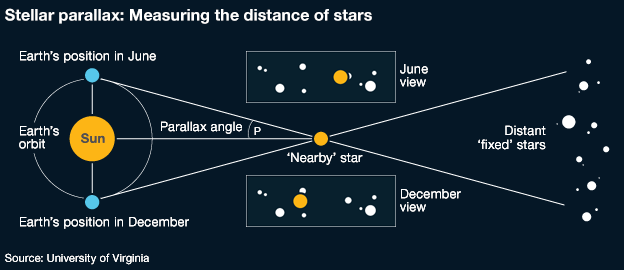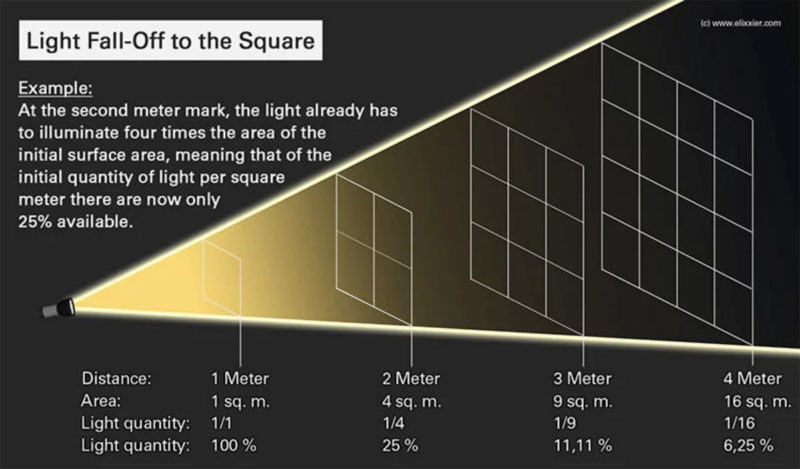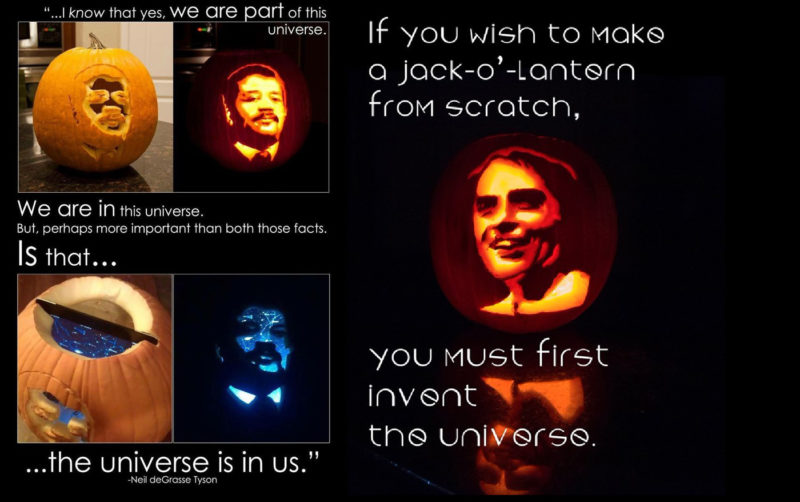October 28, 2017 11:32 am
Candles Aren’t Just for Jack-o-Lanterns — Standard Candles Explained
Today’s guest blog post is by StarTalk intern Kirk Long. Kirk is majoring in astrophysics while minoring in applied mathematics and piano at Boise State University. He spends his summer weekends working at the largest public observatory in Idaho, the Bruneau Sand Dunes State Park Observatory, where he gives educational astronomy presentations and operates various large telescopes for the public. Kirk also helps run the StarTalk Snapchat (startalk-radio).
Have you ever wondered how we measure cosmic distances? You’ve probably learned about how vast the cosmos is — that we’ve measured galaxies billions of light years away, and we’ve even determined that many of them are moving away from us at a frightening pace as the universe expands (at a rate of about 68 kilometers per second per megaparsec, but how do we know that? If you’ve given it any thought, what at first might seem a simple question quickly gets complicated.
If you’re just thinking about things from an Earthly perspective, it’s pretty easy to determine how far away something is and what direction it’s moving. Most of the time here on Earth we have the ability to use a reference frame — if I’m driving down a desert road towards some mountains (I’m picturing the desolate stretch of highway before the Sierra Nevadas on the way to California) and I see a car off in the distance, I can easily say that obviously the car is closer than the mountains, and that likewise if the car appears to grow in size that it’s moving towards me. And if I wanted to get really technical (like the police do) I could use a radar gun and measure the time it takes for those radio waves to strike the car and return back to me, and if I did that for a few seconds I could tell both the speed the car was travelling and the distance it was away from me with pretty precise accuracy. When we use our telescopes to peer out into space, however, the background for pretty much everything in the cosmos is the same — a sea of empty black. It’s a lot harder for us to even use the reference frame idea to determine approximately how far away something is, and unfortunately even at the speed of light our friendly police officer would be long dead before he/she could gather the requisite data using his/her radar gun to write the Andromeda galaxy a speeding ticket for careening towards us. Of course, things are dimmer the further they are away, but using the magnitude of an object to determine its distance is also tricky. If you have no frame of reference to put an object in you can’t tell if it’s actually exceptionally bright and just also exceptionally distant, or if it’s exceptionally dim and right outside our doorstep (cosmically speaking). Astronomers are a crafty bunch, though, and luckily they have helped solve this problem as best they can. I’m going to talk about two of the most common methods we apply to measure distances at universal scales: parallax and standard candles.
The Parallax Method: Using parallax to measure stellar distances is actually very intuitive, but applying it to a cosmic scale wasn’t successfully done until 1838, when Friedrich Bessel successfully measured the distance to the star 61 Cygni. You can observe how this method works with your own eyes — if you close one eye, then alternate between opening your right and left eyes, you will notice that objects appear to shift ever so slightly. If you measure the angle of this shift, and you know the distance between your eyes, you can create a triangle and use trigonometry to find the distance to the object. As the Earth shifts position in its orbit throughout the year, this creates a similar shift in perception of the stars in the sky, and if you measure this difference — taking the measurements about six months apart, because that’s when the shift between observations will be largest and most noticeable — you can determine the distance to that star using the angle measured and the distance from Earth to the Sun.

This diagram illustrates the concept of stellar parallax, and how we use it to measure cosmic distances. Pretty smart, right? Graphic credit: University of Virginia.
Unfortunately, this method only works for relatively close objects in our cosmic neighborhood. The shift in position due to Earth’s orbit is tiny compared to the vast distances to even the nearest stars. The closest star to the sun, Proxima Centauri, has a parallax of just 0.77 arcseconds (there are 3,600 arcseconds in a degree) and it’s only four light years away. This is why it took us so long to even be able to measure stellar parallax, as it requires very precise measurements, but it’s also why this method doesn’t work for objects much further away than 300 light years. If we had a larger orbit, we could measure further distances using this method, so if we had a telescope like Hubble orbiting out near Pluto we could attain a much better measurement. To get really precise, we would have to wait 124 years between measurements to allow the telescope to complete a full orbit (Pluto takes about 248 years to orbit the Sun). The Earth doesn’t just move around the Sun, but the Sun is also moving around the Milky Way. This means that as the Sun shifts, we can also use that to measure parallax of objects, which will eventually yield more accurate measurements than the more commonly used Earth-Sun system — we just have to wait for the Sun to move far enough in its orbit around the galaxy, and one orbit takes about a quarter of a billion years. Unfortunately, objects like distant galaxies don’t appear to shift discernably at all over human timescales, which means need to use a different method to deduce their distance to us.
The Standard Candle Method: How then do we go about determining these distances? Standard candles. A standard candle allows astronomers to answer the pesky question about whether an object is really bright or just very close to us, and they do so in an ingenious way. A standard candle is any object that astronomers know the absolute magnitude of. Absolute magnitude is defined as how bright an object would be if it were an arbitrary distance (10 parsecs, or 32.6 light years) away from us, whereas apparent magnitude is a measure of how bright that object actually appears to us in the night sky. If you know an object’s absolute magnitude, and you observe that it’s say, 100 times dimmer than it should be, then you would be able to determine the object’s distance. Light gets predictably dimmer as distance increases, and it follows what we call the inverse square law, which simply means that as the distance to a source of light increases by some distance d the intensity of light received at any particular measuring point will decrease by . For example, if the Earth were twice as far away from the Sun, you might intuitively assume that it would receive half as much sunlight. However, using the inverse square law, we can see that if the Earth were twice as far from the Sun it would only receive ¼ the amount of solar radiation. You can see why distance is so important to a planet’s temperature, and thus why the goldilocks zone of habitability is relatively small. We can use the inverse square law to work backwards and determine the distance to the light source, as long as we know how bright the light source would be at a different, arbitrary distance — for example, we could measure the amount of radiation a rover on Mars receives and compare that to the amount we receive here on Earth to determine how far away Mars is.

This diagram illustrates the principle of the inverse square law. Graphic credit: www.elixxier.com.
But how do we know some things are only so bright? This is where the real brilliance comes in, and it is critical to understanding much of what we know about our modern universe. In 1924 a guy named Edwin Hubble (you may have heard of him) was doing research on a special kind of star called a Cepheid variable — these are stars that pulsate in the sky, periodically dimming and brightening. Research done earlier by another pioneering astronomer, Henrietta Swan Leavitt, had clearly shown a well-defined relationship between the luminosity and period (how long the cycle is) of these stars. Using that, Hubble took detailed measurements of several of these stars in what was then called the Andromeda Nebula — and conclusively proved for the first time that the Milky Way was not the only galaxy in the cosmos (we of course now know the Andromeda nebula is in fact an entirely separate galaxy). Based on his measurements of the period of the Cepheid variables within Andromeda, he knew they should have a certain corresponding absolute magnitude, and working backwards he was able to discover the truly mind-boggling distance from our galaxy to the Andromeda galaxy: more than two million light years. Hubble later used this same technique, combined with measurements of redshift, to show that the universe was not only massive but also expanding. Other kinds of variable stars have also been used as standard candles — astronomer Harlow Shapley used RR Lyrae variable stars to first estimate the size of the Milky Way and our own position in it.
Variable stars aren’t the only standard candle astronomers have in their arsenal, however. Another incredibly useful standard candle is the Type Ia supernova. Most supernovae, while spectacular events, can vary in brightness depending upon the mass involved in the explosion, and thus aren’t very useful in getting precise measurements of cosmic distances. This special kind of supernova was modeled by pioneering astrophysicist Subrahmanyan Chandrasekhar, for which NASA’s Chandra X-Ray telescope is named. He crafted an important astrophysical limit — the Chandrasekhar limit — which says that the mass of a white dwarf star cannot exceed about 1.4 times the mass of our own Sun. This is important, because many stars are in binary systems, and if we find a white dwarf in a binary system close enough to its companion star, the dense gravity of the white dwarf will pull material off of the larger star onto its surface. Eventually, the white dwarf can accrete enough mass to reach the Chandrasekhar limit and explode in a supernova, and since we know pretty accurately how much mass was involved in that explosion, we can determine its absolute magnitude and thus calculate how far away it is from us. There are other objects that can be standard candles (any object whose absolute magnitude can be approximated can be used) which follow similar lines of thinking, but these are both representative examples with fascinating histories behind them.
These of course aren’t the only methods we use to measure cosmic distances, but they are two important and reliable ways of doing so. We are always coming up with new and exciting ways to fathom the cosmos, and as our technology advances our measurements will only grow more precise. For example, recent advancements in our ability to detect gravitational waves has opened up an entirely new way to measure distances in the cosmos. Waves of gravity propagate across the universe at the speed of light, but the events that often create them (such as merging neutron stars) have a set “loudness” (akin to an absolute magnitude), so the only variable that affects how big they are on Earth is our distance to the source. When we combine those measurements with measurements in the electromagnetic spectrum, like we did in the most recent event seen as two neutron stars collided, astronomers can gather both an accurate measure of both the distance to an object and its redshift, which allows us to precisely calculate the Hubble constant (the rate of universal expansion) with significantly less uncertainty.
This isn’t just esoteric knowledge to have — it’s practical here on Earth too. When you see your neighbor’s candle flickering from within their delicately carved jack-o-lantern, bring up how it’s connected to our measurements on universal scales (if you want them to leave you alone for a few months, that is). From all of us at StarTalk, we’re wishing you a happy (and scientific) Halloween!

Jack-o-lanterns inspired by Neil deGrasse Tyson and Carl Sagan, carved by @JLSpradling, via @exploreplanets.
Get the most out of StarTalk!
Ad-Free Audio Downloads
Priority Cosmic Queries
Patreon Exclusive AMAs
Signed Books from Neil
Live Streams with Neil
Learn the Meaning of Life
...and much more

 Become a Patron
Become a Patron

